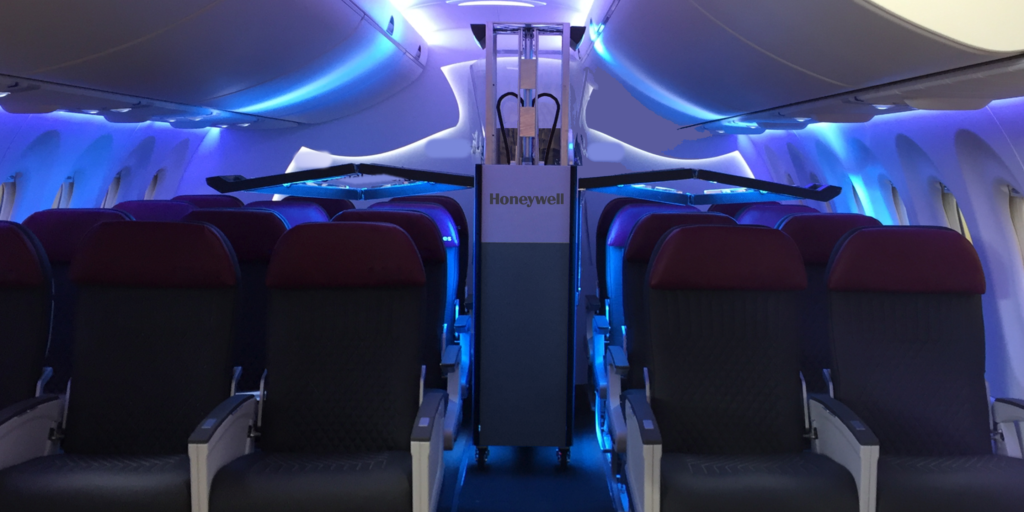Honeywell’s UV Cabin System Can Disinfect an A320 in 10 Minutes
Share

In the wake of the coronavirus outbreak, Honeywell’s partnership with Dimer UVC Innovations could put the virus-zapping GermFalcon device, which has become somewhat of a sleeper hit, in widespread use across the aerospace industry.
Honeywell has announced an exclusive strategic business relationship with Dimer UVC Innovations to bring ultraviolet-C cleaning to the aerospace industry. The Honeywell UV Cabin System applies UVC light to reduce various viruses and bacteria, to high-touch aircraft cabin surfaces. While the product has not yet been tested on COVID-19 but clinical tests conducted on SARS and MERS outside of aircraft using similar UVC lamps were found to reduce those viruses by levels as high as 90-99.999%.
Compared to aircraft cleaning methods that have emerged since the COVID-19 outbreak, such as hand wiping or fogging, the Honeywell UV Cabin System only requires one operator and can cover targeted areas in a typical single aisle aircraft in lesser time. “In comparison, airlines may use two to four people for fogging, which may take 15 or more minutes depending on the level of coverage. Properly applied, the Honeywell UV device covers the same surfaces, every time it is used,” said Honeywell spokesperson Adam Kress.
The device is effective on areas that come in frequent contact with passenger fingers and hands such as seats, armrests, headrests, tray tables, overhead reading lights and ventilation controls, sidewalls, windows and window shades, overhead bin doors – even the aisle floor. “Most people will tell you the most contaminated surface on a plane is in the lavatory or on the tray table; in reality, the ‘germiest’ surface is the top of the seatback on the aisle. Most passengers use it as a handrail,” Dimer president Elliott Kreitenberg explained.
However, the undersides of cabin components or areas in shadows would need an additional cleaning method, as would dirty surface areas. “Cleaning procedures for rubbish and shmutz are still required, but chemical disinfectants are not,” Kreitenberg said.
Cleaning of an Airbus A320 took 10 minutes, including three lavatories, two galleys and two passes through the cabin (first class and economy).
In recent tests, cleaning of an Airbus A320 took 10 minutes, including three lavatories, two galleys and two passes through the cabin (first class and economy). The device, which is about the size of a beverage trolley, operates with an internal battery that takes about two hours to charge, with recharging recommended after operation on approximately 12 aircraft.

Honeywell has tested the UV light’s effect on the color and structural integrity of multiple samples of cabin interiors materials with good results.
The device, formerly called GermFalcon, was first introduced by Dimer UVC Innovations in 2013 and was touted by its inventor, orthopedic surgeon Arthur Kreitenberg, as “technology that is already being used in hospitals.” However, interest in the product didn’t take off until the recent pandemic. Dimer continues to apply UVC technology in hospitals and at airport lounges and terminals with a different product, the UVHammer, which can cover 5,000 square feet per hour, and is already in use at Seattle’s Paine Field Airport.
“I think we will see infection prevention protocols added to daily airline cleaning sequences. Disinfecting more often will limit each passenger’s exposure even more,” said Kreitenberg, adding that standardizing GermFalcon for use across the global airline industry was the vision from day one. “We worked very hard to make this an easy decision for airlines, teaming up with a major aerospace partner like Honeywell makes it even easier.”
Read about the origins of the GermFalcon technology in “Where to From Here?” a feature from the June/July issue of APEX Experience magazine that looks at how the passenger experience will change in the age of the coronavirus.


